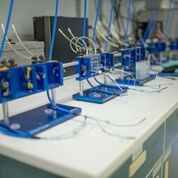Vertex and Treating CF: Stepping Out on Long Road to ‘Medical History’

Vertex’s “Cell Daycare,” where cells isolated from human lungs are stored and developed. (Photo courtesy of Vertex Pharmaceuticals)
Editor’s note: This is the first of a four-part series looking at Vertex Pharmaceuticals and its “all in for CF” approach. We begin by recounting the discoveries that made three disease-modifying treatments for cystic fibrosis — by the same science team — possible in a matter of years.
To the interested public, Vertex Pharmaceuticals is known as the cystic fibrosis company — the group that, as its slogan implies, is “all in for CF.”
Rightly, the company is quick to note other treatments in its development pipeline, mainly for acute pain and spinal cord injury, and that it’s working in other “difficult disease areas” like sickle cell disease and that of alpha antitrypsin, a genetic disorder of the lungs and liver.
But, as Vertex’s product pipeline makes clear, cystic fibrosis is front and center — and with good reason.
As of now, the only disease-modifying therapies for CF — a rare disease caused by mutations to the CFTR gene that lead to sticky mucus buildup in crucial organs — are all Vertex treatments. And all have been approved in the past six years.
Vertex also is continuing to improve and expand on those three — Kalydeco (ivacaftor), Orkambi (lumacaftor/ivacaftor), and Symdeko (tezacaftor/ivacaftor, ivacaftor) — which are able to help about 50 percent of CF patients worldwide. A stated goal of new clinical trials, both those underway and planned, is to raise that number to 90 percent.
Although game-changers in CF, how these therapies came into being is “a long arc of a story.” And arguably, it’s the stuff of “medical history,” Vertex officials said in a series of interviews looking at the company and its ground-breaking work in a rare disease.
As they described — and as is detailed in this series based on interviews by Cystic Fibrosis News Today — work began in the 1990s without any idea if a small molecule could affect the CFTR protein, much less coax it to work as it should. Animal models to test candidate molecules weren’t around, either.
Such essentials had to be improvised by a research team at Vertex, a small group of people “together longer than the Beatles,” who spent years considering, building, and evaluating whether small molecules — yet-unknown protein correctors and potentiators — could do what they wanted them to do.
This series opens with a look at those formative years. It details how these first disease-modifying therapies came to be the focus of one company, through the efforts of one scientific team — with the first, a corrector named Kalydeco, winning the U.S. Food and Drug Administration’s (FDA) approval some 23 years after CFTR was discovered to be the disease-causing gene.
The series then goes on to describe these therapies and the work that went into eventually winning wide regulatory approval.
Subsequent articles will look at some “next generation” therapies — triple combinations now in clinical trials to gene therapies still in early development — before concluding on a few points of controversy (like treatment prices) and Vertex’s outreach to the CF community at large.
All-in-all, it’s “a remarkable journey” and one that “I do consider it unprecedented, as far as I know … in the history of medicine,” said David Altshuler, MD, PhD, Vertex’s chief scientific officer. Compounds had already been used to treat complex diseases like HIV and cancer, but “I’m not aware of any other case in history where … a single team discovered all the mechanisms of action [of three treatments for one disease] and proved their value.”
Altshuler added: “I feel it’s important to say, in the history of medicine … This is medicine. I mean, this is science of the highest order.”
In the beginning, ‘a blank sheet of paper’
That team — led by Paul Negulescu, PhD, now a senior vice president at Vertex — included, among others, Peter Grootenhuis, PhD, “a master project leader,” and Sabine Hadida, PhD, a chemist with the “uncanny ability to visualize every compound we ever made and do the chemical design in her head,” Negulescu said.
The researchers were working for Aurora Biosciences at the time, which Vertex acquired in 2001.
They would build on an incredible discovery made by scientists in Canada in 1989 — that of CFTR to be the disease-causing gene for cystic fibrosis. Hundreds of genetic mutations eventually would be identified in this disease, but pinpointing that gene was key — and led to its team leader Lap-Chee Tsui, PhD, sharing this year’s prestigious Warren Alpert Foundation Prize with four others, including Negulescu.
Within a year, the Cystic Fibrosis Foundation (CFF) approached Aurora about developing an assay — a tool for quickly screening large numbers of compounds — to pick out any that might act on the dysfunctional protein. CFF’s goal, Negulescu said, was to “try to get started in drug discovery for CFTR.”
Negulescu and his team, armed with “a blank sheet of paper,” took on the challenge.
Over the decades that followed, these researchers would screen more than a million compounds, going through entire libraries of small molecules looking for signs of CFTR activity in them.
We had no “roadmap,” Negulescu said, no assays ready and able to spot changes in a cell’s electrical field that signal a response to a molecule, indicative of “the CFTR protein being functional.” No CF animal models existed to test any showing promise.
Negulescu’s team took that blank page, and set out on an entirely new way of conducting assays and evaluating results.
They came upon published papers suggesting it was possible to harvest lung cells, grow them in the lab, and use them to measure CFTR response and activity. This was a bold — unknown and untried — strategy, and one the studies even suggested would not necessarily yield consistently reliable results.
“When we first suggested making this our pharmacology model, our advisors were pretty skeptical,” Negulescu said.
But with few other options, the researchers gave it a shot. The CFF helped Vertex get discarded lungs from CF patients undergoing transplants. Negulescu credits Tim Neuberger, PhD, another team scientist, with perfecting ways to isolate and grow these cells in the lab.
Amid trial and effort, they hit on a winning approach.
“That assay has shown itself to be very predictive and has become kind of a gold standard in the CF field,” Negulescu said.
But success followed years spent isolating cells from the donated lungs, and learning to harvest and grow them in dishes for compound testing.
“The first time we all looked through a microscope and saw the cilia [tiny hair-like structures that help keep the airways clear of mucus and dirt] beating on the surface of the CF airway cells after we added our compounds, scientists at our site were lining up to look at the cells,” said Negulescu. “I think that was when we really began to believe we were on the right track.”
This was around 2001, when work shifted to Vertex from Aurora — including that of Negulescu’s team.
Vertex’s priority at this time, and for much of the decade that followed, was in developing and marketing a potential blockbuster treatment for hepatitis C, called Incivek. But a competitor, Gilead, was close on the company’s heels — and ultimately would win — having gained approval of its oral hepatitis C treatment, Sovaldi, which proved to be more popular.
Vertex stopped selling Incivek in 2014, and began shifting its focus to CF.
That “side project” it had acquired — the one started at Aurora some 20 years earlier — was beginning to bear fruit.
Best-laid plans
From the outset, Negulescu and his team were looking for a way to treat the most common known mutation in CF — delta F508.
They knew this would mean a combination treatment, despite the complexities it demanded, because two problems were specific to F508del.
In healthy people, the CFTR protein forms within cells then travels to the membrane. Once there, it acts as a channel allowing chloride ions to flow out of the cell.
Among the hundreds of genetic mutations that disrupt how this protein works, the F508 deletion causes it to fold incorrectly. It never makes its way to the cell membrane at all.
F508del’s second problem is shared with less common “gating” mutations. These mutations allow the protein to reach the membrane, but prevent it from opening properly once it arrives. Essentially, the CFTR protein sits on the membrane, with ions unable to flow through.
In both cases, the chloride imbalance that results causes mucus to build in organs like the lungs and pancreas, wreaking havoc in the form of inflammation and repeat infections.
When we started, we said “as any scientist would, ‘Hey, let’s start trying to fix the most common mutation, delta F508’,” Negulescu said, knowing that meant screening for correctors and potentiators at the same time.
That’s much more difficult than it sounds, Altshuler added.
“To find a chemical that can do what you hope it to do … and not do anything else undesirable that would cause a safety or tolerability issue” — in other words, one that’s absorbed well by the body, hits the target it needs to fix without making the person sicker, and then is “excreted correctly” so not to accumulate in someone’s system — “is an incredibly hard problem,” he said.
To do this multiple times — in compounds, all targeting the same protein and acting in concert at the same time — is much harder.
For F508del patients, researchers needed to find a “corrector” — a compound that could “correct” the shape of misfolded CFTR proteins and help them travel to the cell membrane. Then they needed a “potentiator”— a compound that could hold the CFTR protein channel open, like a door wedge, so ions could flow through.
And they needed to determine the two compounds could be delivered directly to the protein at the same time, and work together safely — without damaging or disabling drug-to-drug interactions.
While this best-laid plan was in discovery, “as often happens in science, you have a little bit of serendipity, things [that] don’t happen exactly the way” you intended, Negulescu said.
In Vertex’s case, serendipity came in the form of ivacaftor, a potentiator, a “really good-looking compound, that later became Kalydeco” — but a partner was nowhere in sight.
Rounds of discussions followed, with Vertex scientists, the CFF, and others, until the possibility was raised “of taking the potentiator by itself into a very rare mutation group” — one with CFTR protein at the cell surface but not “functioning well.”
“In retrospect, if we had started with a double combination, but it had been, maybe, less effective in the delta F508 patient, we might not have learned as much early on,” Negulescu said.
Serendipity, indeed. Perhaps a fan of the Rolling Stones, he added: “You don’t always get what you want, but sometimes you get what you need.”
Next: Kalydeco, Orkambi, and Symdeko, and the journey from discovery to CF’s first disease-modifying therapies.










